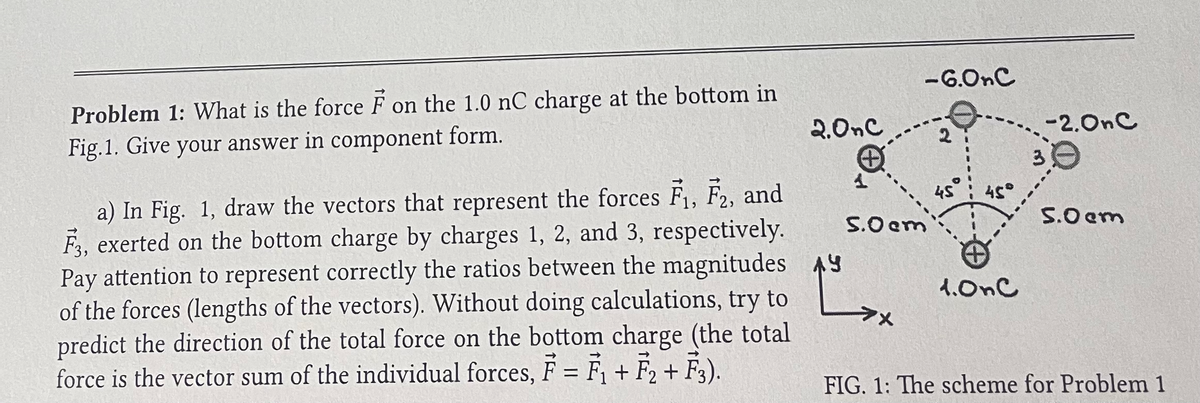Problem 1: What is the force F on the 1.0 nC charge at the bottom in Fig.1. Give your answer in component form. a) In Fig. 1, draw the vectors that represent the forces F₁, F2, and F3, exerted on the bottom charge by charges 1, 2, and 3, respectively. Pay attention to represent correctly the ratios between the magnitudes of the forces (lengths of the vectors). Without doing calculations, try to predict the direction of the total force on the bottom charge (the total force is the vector sum of the individual forces, F = F₁+F₂ +F3). 2.OnC S.0 cm -6.OnC 45° 1.OnC -2.0nC 30 5.0 cm FIG. 1: The scheme for Problem
Problem 1: What is the force F on the 1.0 nC charge at the bottom in Fig.1. Give your answer in component form. a) In Fig. 1, draw the vectors that represent the forces F₁, F2, and F3, exerted on the bottom charge by charges 1, 2, and 3, respectively. Pay attention to represent correctly the ratios between the magnitudes of the forces (lengths of the vectors). Without doing calculations, try to predict the direction of the total force on the bottom charge (the total force is the vector sum of the individual forces, F = F₁+F₂ +F3). 2.OnC S.0 cm -6.OnC 45° 1.OnC -2.0nC 30 5.0 cm FIG. 1: The scheme for Problem
Chapter5: Electric Charges And Fields
Section: Chapter Questions
Problem 118AP: Three charges are positioned at the cornets of a parallelogram as shown below. (a) If Q=8.0C what is...
Related questions
Question

Transcribed Image Text:Problem 1: What is the force F on the 1.0 nC charge at the bottom in
Fig.1. Give your answer in component form.
2.OnC
a) In Fig. 1, draw the vectors that represent the forces F₁, F2, and
F3, exerted on the bottom charge by charges 1, 2, and 3, respectively.
Pay attention to represent correctly the ratios between the magnitudes y
of the forces (lengths of the vectors). Without doing calculations, try to
predict the direction of the total force on the bottom charge (the total
force is the vector sum of the individual forces, F = F₁+F₂ +F3).
5.0 cm
7x
-6.0nC
45°
1.OnC
-2.0nC
30
5.0 cm
FIG. 1: The scheme for Problem 1
Expert Solution
This question has been solved!
Explore an expertly crafted, step-by-step solution for a thorough understanding of key concepts.
This is a popular solution!
Trending now
This is a popular solution!
Step by step
Solved in 2 steps with 2 images

Knowledge Booster
Learn more about
Need a deep-dive on the concept behind this application? Look no further. Learn more about this topic, physics and related others by exploring similar questions and additional content below.Recommended textbooks for you

